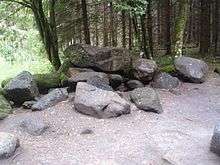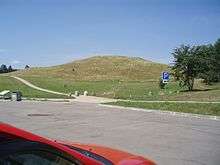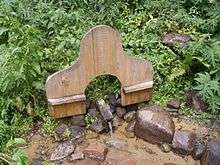Samogitia
Samogitia (Lithuanian: Žemaitija, literally lowlands) is a region of western Lithuania.
Cities
- 🌍 Kretinga
- 🌍 Palanga — coastal resort town, region's only window to the sea
- 🌍 Šiauliai
- 🌍 Telšiai — the capital of Samogitia, nice and lively town.
- 🌍 Tytuvėnai — town, boasting famous monastery and some nice lakes.
- 🌍 Židikai — town, where famous writer Šatrijos Ragana has lived and has written part of her best works.
Other destinations
- 🌍 Žemaičių Kalvarija — famous pilgrimage site, most visitors come in the beginning of July to visit the large church festival.
- 🌍 Hill of Crosses — site of religious significance, north of Šiauliai.
Understand

Historically, Samogitia had the biggest autonomy in Lithuania and had its own grand dukes (the most famous being, probably, Vykintas and Kęstutis). People of Samogitia fiercely resisted from being "colonized" by dukes of Lithuania and by the Order of Germans (crusaders), winning several important battles. Samogitia remained pagan for the longest time - its people were baptized the last of Lithuania. Today, one can find a mixture of pagan and christian tastes, represented by sacral sites and folklore.
Talk
The Samogitian dialect is the one that varies most from official Lithuanian. People from other regions of Lithuania may find it unusual. In Telšiai, at the cathedral, you can find examples of forged/carved Samogitian texts.
Get in
You might fly directly to Palanga International Airport.
Get around
By car
Traveling by car you can admire the hilly landscape and reach some beautiful and significant places difficult to reach by other means.
See



Samogitia is mostly hilly, with a lot of forests.
- 🌍 Mount Šatrija (in the region of Telšiai, near the town of Luokė). Supposedly sacral pagan place and former village site. The mount, being in this location and standing out (228,7 m above sea level) from the surroundings, offers stunning views of Samogitia all around. Šatrija is braided with legends, one of which tells that once there was no hill, but a church stood there. Then all Samogitia witches had gathered in this place and have poured the church over with the ground - and so have made the hill.
- The grave of Vytautas Mačernis, Žemaičių Kalvarija (close to Šarnelė village (latitude and longitude points there), some 30 km north of Plungė. There is a pointer to the grave site from the village). Vytautas Mačernis is a famous Lithuanian poet, who loved nature, studied philosophy, languages and nature sciences. Mačernis has tragically died, being a bit late to escape the soviet occupation during WW2. Close to Mačernis grave a house can be seen, where Mačernis has lived. On the way from car parking to the grave there is a spring.
- 🌍 Lopaičiai sacral place (some 16 km east from Rietavas via Tverai). Supposedly one of the main pagan sacral places, and the place, where Samogitia grand duke Vykintas has lived. The place is very well-prepared for tourists: wooden paths lead you where it would be otherwise almost impossible to walk, there are numerous information tables and route signs. The site includes Lopaičiai mound, some banks of river Aitra, the spring, pagan ritual stones and science places. On a sunny day, just after the rain, the feeling in the air there may be fabulous.
Do
You might want to try passing kūlgrinda (underwater stony road, used for defense in medieval times) near the lake Lūkštas. For the possibility, contact the administration of Varniai regional park.
Eat
Samogitia has delicious and unique food, which is related to the rest of Lithuania, but has a unique taste. Especially good are Samogitian foods made from potatoes, such as kleckā, potato cake kogielis and stuffed potato sausages viedarā.
Drink
Samogitia has a long and great beer making tradition, preserved by local brewers.